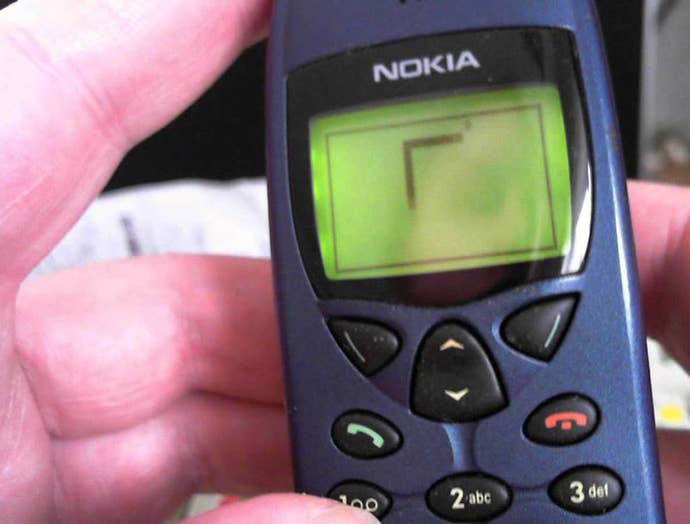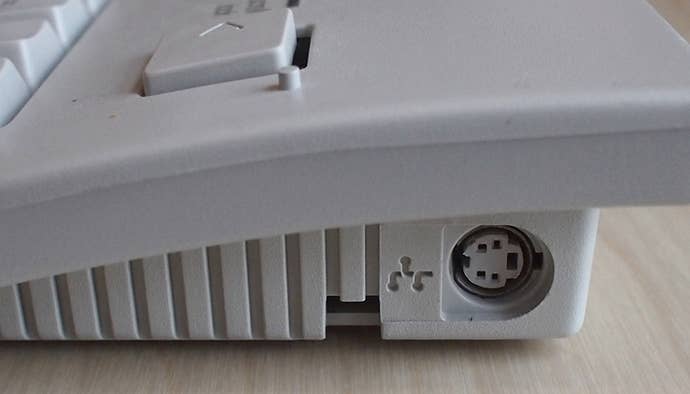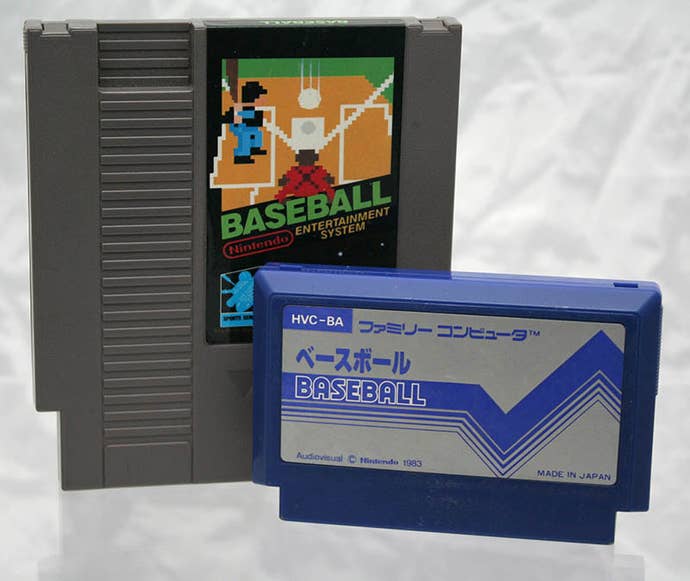A Trip to the Graveyard of Lost Game Technology
They say the medium's the message, but let's hope that's not true of these dead formats. The good and bad of video game tools that have fallen into obsolescence.
This article first appeared on USgamer, a partner publication of VG247. Some content, such as this article, has been migrated to VG247 for posterity after USgamer's closure - but it has not been edited or further vetted by the VG247 team.
The Coleco Chameleon saga appears to have come to a decidedly anticlimactic end, bringing with it the death of a quixotic dream: The return of game systems powered by ROM cartridges.
I don't know that building a modern console to run on expensive, limited cartridges would have necessarily offered a superior gaming experience... but I can, at least, understand the nostalgic fondness for the format. Cartridges had both weaknesses and strengths, and there is something marvelously primal about shoving a cart into a console slot and hitting the power button that resonates even today. Still, technology goes out of fashion for a reason. Cartridges died off because other formats did a better job of fulfilling the purpose of delivering video game content to consumers, simple as that. More so than any other creative medium, the underpinnings of video games continue to evolve, and while the fundamental experience of gaming hasn't changed that much since 1975's Home Pong, the mechanisms through which we share those experiences has. Let's take a moment to remember the tools of bygone gaming days.

Cathode Ray Tubes
As seen in: Any game console-owning household between about 1950 and 2008.
What they were: Televisions, you know. Before televisions became gigantic flat screens, they took this primal form... which, ironically, was at once larger than modern TVs yet also much smaller. Rather than depict on-screen images with an array of crystals or diodes, CRTs used an electron gun that "painted" light on tiny phosphors.
Why they had to go: CRTs came with a huge number of downsides. For one thing, they were massive — the technology required a bulky box to house the image projection devices, and the larger the screen became, the deeper the set needed to be. Don't even ask about high-definition CRTs, which nearly required their own ZIP code. Because the screens themselves contained a huge amount of glass and lead, their weight grew exponentially with the size of the screen. A single adult could move a 27" CRT around alone, but just barely; anything larger than that became nearly impractical (not to mention dangerous to their lower back). And speaking of danger, CRTs contained components that could potentially deliver a fatal electric shock. Compared to light, convenient, huge, and safe LED televisions, it's little wonder the world was ready to kick CRTs to the curb.
Why we'll miss them: For all their flaws, CRTs had plenty of perks. The phosphor glow of those screens possessed a gentle luminosity that modern TVs lack. Plus, CRTs offered a huge advantage for gaming: Zero lag. Even the best LED TV introduced a frame or two of lag to a game, which has a huge impact on frame-specific genres like fighters and shooters. Plus, the nature of CRT imaging meant those TVs supported dynamic screen resolution changes with no artifacts or dropouts. Some games (especially old ones) simply look better on CRTs, which is why high-end tube TVs have become eagerly sought by retrogaming fans and will only increase in price as the finite remnants of this defunct technology slowly fail over time....

Magnetic Media
As seen in: Nearly all personal computers prior to circa 2000, and some consoles (Famicom Disk System, Nintendo 64DD)
What they were: Various storage formats that used magnetism to record data. Technically, this technology is still around; most hard disk drives belong to the magnetic media category, but even those are slowly being phased out in favor of solid state drives.
Why they had to go: Go on, get your Insane Clown Posse jokes out of your system now. Magnetic media lost favor not because it was so inscrutable, but because of its fragility. Diskettes, tape cassettes, Zip drives... nearly every veteran gamer has a horror story or two about losing a beloved game or some precious save data to a magnet. If the magnets didn't get them, a drive failure did; magnetic media had multiple points of weakness, and could be ruined by a passing breeze (or so it seemed). And their mechanical nature meant they offered far slower data access than competing forms of storage, like integrated circuits.
Why we'll miss them: For all their deficiencies, magnetic storage formats had two huge advantages: They were cheap, and they were rewritable. What did it matter if you lost a few diskettes to a fridge magnet? You could buy a replacement for pennies. And the ability to write games to low-capacity analog media had the same appeal as home taping: It presented an opportunity for personal expression. Sure, you can save the entire libraries of every 8- and 16-bit cartridge game ever produced on a Micro SD card, but how are you supposed to customize a chip smaller than a dime with little doodles on the label?

Keypad Controls
As seen in: The days before smartphone gaming.
What they were: Before we had touch-screen phones, we had cell phones that looked more like traditional phones, with a numeric touch pad. And for some reason, people made games for those phones... and not just Nokia's Snake, but complex games — including an original Castlevania title!
Why they had to go: Touch phones replaced numeric keypads with glass screens, and for good reason: Touch is just so much more versatile. With touch screens, you can program your interface to be whatever you like; with a numeric keypad, you have the same fixed 3x4 grid of buttons no matter what. Controlling games on keypads was an exercise in frustration and tears.
Why we'll miss them: We won't, really, but when it comes to classic action games it's hard to say touch-based virtual controls are necessarily an improvement...

Light Guns
As seen in: Back to the Future Part II.
What they were: Exactly what they sound like: Game peripherals that could be used like handguns, allowing players point-and-shoot precision with no need for joysticks or mice. Light guns didn't actually fire a beam of light, but rather could "read" the light of a screen to determine whether or not a player had hit their target.
Why they had to go: Light guns were left behind by technology. When televisions changed from CRT to LCD/LED, they rendered devices like Nintendo's Zapper and Namco's GunCon obsolete. Zapper and its kindred were done in by high-definition screen lag, as they relied on a precise series of single-screen on-screen events to register hits: One frame after firing, targets would flash white. On the next frame, the screen would turn completely black to ensure players weren't simply pointing at a light bulb. The GunCon, on the other hand, was specifically keyed to CRT technology, and can't read modern televisions at all.
Why we'll miss them: This is really the one case where vanished technology faded not because of its inherent flaws but simply because the devices it relied on also disappeared. Light gun games remain as addictive and fun today as they were 20, 30, even 40 years ago. Game developers have come up with convincing fakes, such as the Wii Zapper and who knows what kind of positional tracking that'll come from VR, but it's still not quite the same.

Proprietary Connectors
As seen in: Almost every computer and console made prior to about 2005.
What they were: USB? Bluetooth? Forget about it. Back in the olden days, we had to deal with a seemingly infinite array of console- and computer-specific connectors in order to hook up everything from a controller to a keyboard to a disk drive.
Why they had to go: Legacy hardware is both anathema to consumer goodwill and the bane of preservation. There's nothing more irritating than trying to gather files from an old computer and realizing it requires some arcane cable that no one makes anymore and sells for $100 on eBay. Industry standards like USB have made life so much easier for everyone, standardizing cables, connections, and even capabilities like plug-and-play. Even console makers, whose entire business revolves around closed platforms, have given in and turned to standard USB connections for their controllers and hard drive expansions. Even our-way-or-the-highway Nintendo!
Why we'll miss them: We won't, and the sooner Apple stops forcing us to use overpriced special connectors to plug in our iPhones, the better.

Modems
As seen in: The Dreamcast :3
What they were: "Modulator-demodulators." They were the little devices that you could attach to your computer so that it could communicate over an analog phone line.
Why they had to go: As a medium for the transmission data, phone lines are barely a step above two tin cans connected by a string. Modems were great when online communication consisted of posting plain text on USENET, but they were dreadful for more advanced purposes—like playing online games. They frequently dropped calls, and power surges over the phone line (say, from a thunderstorm) could fry your computers. Their speed topped out at 56Kbps! I'm posting this article from a home connection that currently is giving me download speeds of 290Mbps — that's about 600 times the speed of the fastest modem. The move away from modems liberated the Internet, making possible services like YouTube, Twitch, and worthwhile online gaming.
Why we'll miss them: Maddening as the speed and unreliability of modems could be, there was something soothing about the ritual of dial-up: Listening to your phone punch in a number, the screeching of a handshake, the little tics and changes your computer underwent as your Internet applications began connecting to remote servers. I don't think anyone would give up their modern high-speed connections for the world, but would it hurt to get some sound effects in there?

Mask ROM Cartridges
As seen in: Most game consoles prior to 1993, and in Nintendo systems through the end of Game Boy Advance's life.
What they were: As amusing as it is to talk about "Nintendo tapes," that's a misnomer; Nintendo games had no tape inside them, even if NES packaging was designed to create the illusion of buying a VHS cassette. No, inside each Nintendo cartridge (and Sega, and Atari, and so on) was a solid-state silicon wafer into which the data for a game had been permanently etched: Read-only memory, or ROM.
Why they had to go: Mask ROMs served as the standard medium for console games because they were more durable than low-end magnetic media like diskettes and cheaper than higher-end devices like hard drives. But even so, they were relatively expensive to manufacture (as Nintendo 64 owners discovered when their carts cost $20-30 more than PlayStation CD-ROMs) and tended to be stingy with space. They also lacked the option for save files, unless they had special add-ons (like battery-backed SRAM chips) soldered onto the board. Plus, carts tended to be bulkier and take up more space than other media formats as well. And finally, the manufacturing process was highly specialized, so the production of a cart could take months to fulfill.
Why we'll miss them: Old-school carts made up for their failings with some excellent perks. For one thing, they're incredibly durable; find the dirtiest Atari 2600 cart you can, and chances are good that a little Brasso will have it up and running without trouble. Carts also offered a unique ability to include add-on tech that could enhance a console beyond its actual capabilities: Consider the FX chip in Star Fox, which was a math coprocessor that allowed the Super NES to render 3D, or the UV sensor in Boktai, which made the Game Boy Advance sensitive to sunlight! While DVD-ROMs and digital distribution have made games cheaper and even turned them into "living" products that can be updated as needed, something was definitely lost when Nintendo abandoned carts for its current handhelds' flash media.








